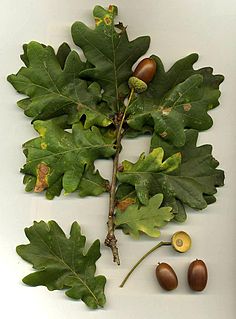
An oak is a tree or shrub in the genus Quercus of the beech family, Fagaceae. There are approximately 500 extant species of oaks. The common name "oak" also appears in the names of species in related genera, notably Lithocarpus, as well as in those of unrelated species such as Grevillea robusta and the Casuarinaceae (she-oaks). The genus Quercus is native to the Northern Hemisphere, and includes deciduous and evergreen species extending from cool temperate to tropical latitudes in the Americas, Asia, Europe, and North Africa. North America has the largest number of oak species, with approximately 160 species in Mexico of which 109 are endemic and about 90 in the United States. The second greatest area of oak diversity is China, with approximately 100 species.

Liriodendron is a genus of two species of characteristically large trees, deciduous over most of their populations, in the magnolia family (Magnoliaceae).

The great egret (Ardea alba), also known as the common egret, large egret, or great white egret or great white heron is a large, widely distributed egret, with four subspecies found in Asia, Africa, the Americas, and southern Europe, recently also spreading to more northern areas of Europe. Distributed across most of the tropical and warmer temperate regions of the world, it builds tree nests in colonies close to water.

Liriodendron tulipifera—known as the tulip tree, American tulip tree, tulipwood, tuliptree, tulip poplar, whitewood, fiddletree, and yellow-poplar—is the North American representative of the two-species genus Liriodendron, and the tallest eastern hardwood. It is native to eastern North America from Southern Ontario and possibly southern Quebec to Illinois eastward to southwestern Massachusetts and Rhode Island, and south to central Florida and Louisiana. It can grow to more than 50 m (160 ft) in virgin cove forests of the Appalachian Mountains, often with no limbs until it reaches 25–30 m (80–100 ft) in height, making it a very valuable timber tree. The tallest individual at the present time (2021) is one called the Fork Ridge Tulip Tree at a secret location in the Great Smoky Mountains of North Carolina. Repeated measurements by laser and tape-drop have shown it to be 191' 10" in height. It is the tallest tree in eastern North America.

The leatherback sea turtle, sometimes called the lute turtle or leathery turtle or simply the luth, is the largest of all living turtles and the heaviest non-crocodilian reptile, reaching lengths of up to 1.8 metres and weights of 500 kg. It is the only living species in the genus Dermochelys and family Dermochelyidae. It can easily be differentiated from other modern sea turtles by its lack of a bony shell; instead, its carapace is covered by oily flesh and flexible, leather-like skin, for which it is named.

The peony or paeony is a flowering plant in the genus Paeonia, the only genus in the family Paeoniaceae. Peonies are native to Asia, Europe and Western North America. Scientists differ on the number of species that can be distinguished, ranging from 25 to 40, although the current consensus is 33 known species. The relationships between the species need to be further clarified.
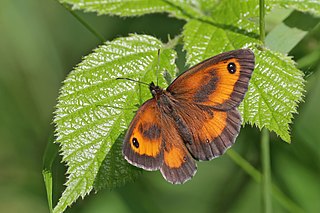
The gatekeeper or hedge brown is a European species of butterfly. Given its preference for warmer weather, the restriction of range expansion can be assumed to be due to climate. Colonies vary in size depending on the available habitat, and can range from a few dozen to several thousand butterflies.

Sceliphron, also known as black mud daubers or black mud-dauber wasps, is a genus of Hymenoptera of the Sphecidae family of wasps. They are solitary mud daubers and build nests made of mud. Nests are frequently constructed in shaded niches, often just inside of windows or vent openings, and it may take a female only a day to construct a cell requiring dozens of trips carrying mud. Females will add new cells one by one to the nest after each cell is provisioned. They provision these nests with spiders, such as crab spiders, orb-weaver spiders and jumping spiders in particular, as food for the developing larvae. Each mud cell contains one egg and is provided with several prey items. Females of some species lay a modest average of 15 eggs over their whole lifespan. Various parasites attack these nests, including several species of cuckoo wasps, primarily by sneaking into the nest while the resident mud dauber is out foraging.

The Lulworth skipper is a butterfly of the family Hesperiidae. Its name is derived from Lulworth Cove in the county of Dorset, England, where the first specimens in Great Britain were collected in 1832 by English naturalist James Charles Dale.

Prunus mahaleb, the mahaleb cherry or St Lucie cherry, is a species of cherry tree. The tree is cultivated for a spice obtained from the seeds inside the cherry stones. The seeds have a fragrant smell and have a taste comparable to bitter almonds with cherry notes.

Great Britain is an island in the North Atlantic Ocean off the northwest coast of continental Europe. With an area of 209,331 km2 (80,823 sq mi), it is the largest of the British Isles, the largest European island and the ninth-largest island in the world. It is dominated by a maritime climate with narrow temperature differences between seasons. The 60% smaller island of Ireland is to the west—together with these islands, along with over 1,000 smaller surrounding islands and named substantial rocks, form the British Isles archipelago.
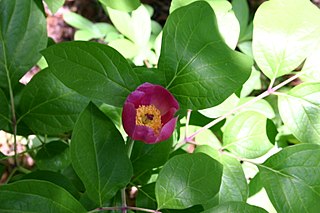
Paeonia obovata is a perennial herbaceous species of peony growing 30–70 cm high. It has white, pink or purple-red flowers and its lower leaves consist of no more than nine leaflets or segments. In English it is sometimes called woodland peony. It grows naturally in warm-temperate to cold China, including Manchuria, and in Korea, Japan, Far Eastern Russia and on Sakhalin.
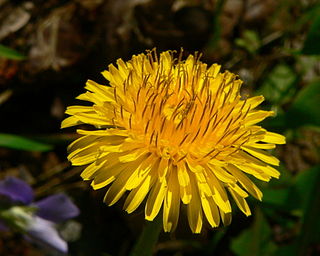
Taraxacum is a large genus of flowering plants in the family Asteraceae, which consists of species commonly known as dandelions. The scientific and hobby study of the genus is known as taraxacology. The genus is native to Eurasia and North America, but the two most commonplace species worldwide, T. officinale and T. erythrospermum, were introduced into North America from Europe and now propagate as wildflowers. Both species are edible in their entirety. The common name dandelion is also given to specific members of the genus.
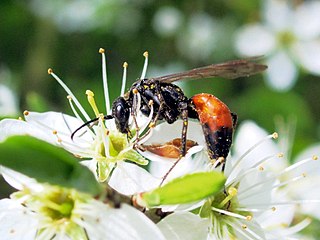
Priocnemis perturbator is a relatively large species of spider wasp which is quite common in Europe. It was previously considered to be the same species as the closely related P. susterai which were lumped as P. fuscus and this means that some early observations of behaviour are not applicable to either species. Even now the two species need close observation under a microscope or hand lens to distinguish them from each other.

Priocnemis monachus is a large spider wasp from New Zealand where it is known as the "black hunting wasp". It is the largest pompilid in New Zealand.

Arachnospila trivialis is a widespread spider wasp of sandy soil areas of the Palaearctic.
Priocnemis susterai is a large species of pepsine spider wasp and is, with Priocnemis perturbator and Priocnemis coriacea, one of three similar species of the subgenus Umbripennis found in Great Britain. All three of these species are characterised by having plentiful erect hair on the face and propodum.

Persoonia coriacea, commonly known as the leathery-leaf persoonia, is a species of flowering plant in the family Proteaceae and is endemic to the south-west of Western Australia. It is an erect to spreading shrub with smooth bark, spatula-shaped or elliptic to linear leaves and bright yellow flowers borne in groups of up to ten along a rachis up to 70 mm (2.8 in) long.
Paeonia algeriensis is a herbaceous species of peony that naturally occurs in the coastal mountain range of Algeria (Kabylie). It has solitary flowers with pink to magenta petals and one or two carpels per flower, that develop into follicles of about 5 cm long.
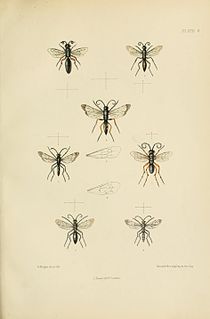
Anoplius concinnus is a widespread Eurasian species of spider wasp.


















